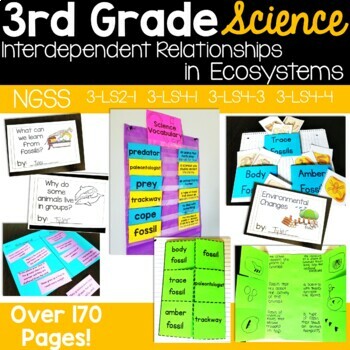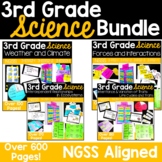3rd Grade Animal Groups Fossils Plant Animal Adaptations NGSS Science Unit
- PDF
What educators are saying
Also included in
- Are you struggling to find engaging science materials for your third grade NGSS lessons? These science units include so many activities and resources that you can use! There are mini books, vocabulary, posters, hands-on activities, passages, and so much more! This is a bundle of my four 3rd Grade NGPrice $38.00Original Price $56.00Save $18.00
Description
Are you looking for a fun way to teach 3rd grade ecosystems? In this third grade science unit students will learn about animal groups, fossils, plant and animal adaptations, camouflage, hibernation, migration, and how environmental changes can impact plants and animals. This third grade science unit has everything you need to engage your students and learn! There are many high interest activities that your students will love!
This third grade unit on interdependent relationships in ecosystems aligns to NGSS* standards 3-LS2-1, 3-LS4-1, 3-LS4-3, 3-LS4-4 and many other state standards.
This unit includes so many activities and resources that you can use! There are mini books, vocabulary, posters, hands on activities, non-fiction passages, practice pages and so much more!
It covers four topics:
- Animals in Groups
- Fossils
- Adaptations and Survival
- Environmental Changes
Download the 47 page preview to see what's included in this 170 page resource!
TEACHERS LIKE YOU SAID...
⭐⭐⭐⭐⭐This resource was so helpful in planning these units in science class! I love that there were so many different types of activities, booklets, and lesson ideas included!
⭐⭐⭐⭐⭐This has been an amazing resource. My science curriculum was lacking and this taught everything I needed to with great illustrations, photographs, and tasks to complete. Definitely worth the money spent.
⭐⭐⭐⭐⭐These units have been lifesavers when it comes to science! Without a curriculum to follow we were struggling, but this was just what we needed! I own all four units and I'm so glad I do!
⭐Save the most by purchasing the 3rd Grade Science BUNDLE! ⭐
It includes this unit and the following other units:
- 3rd Grade Forces & Interactions
- 3rd Grade Weather & Climate
- 3rd Grade Inheritance and Variation of Traits
*NGSS and Next Generation Science Standards are a registered trademark of Achieve. Neither Achieve nor the lead states and partners that developed the Next Generation Science Standards was involved in the production of, and does not endorse, this product.
©Thrifty in Third Grade
ALL RIGHTS RESERVED






